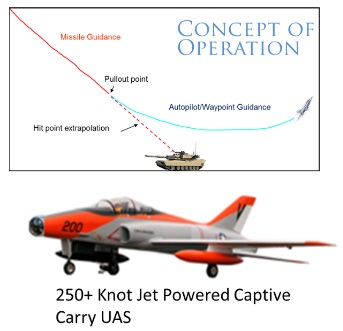
Captive Carry Sensor Testbed (CCST) Prototype
The Captive Carry Sensor Testbed (CCST)
prototype program, developed by Paragon for the
Army Materiel Command and AMRDEC, addresses
a critical gap in current missile testing capabilities.
Hardware-in-the-loop (HWIL) facilities fail to
accurately capture multi-mode sensor operation,
particularly in diverse weather conditions. Paragon
has engineered an innovative solution: a jet-
powered unmanned aerial system (UAS) that
integrates a sophisticated Captive Carry Sensor
Testbed architecture to solve this.
This advanced UAS, capable of exceeding 250
knots, is designed to perform multiple "missile-like"
missions daily. It simulates realistic missile
guidance trajectories, including pullout points and
autopilot/waypoint guidance, allowing for precise
hit-point extrapolation. The system's primary objective is to capture multi-mode sensor
performance characteristics across various weather conditions, supporting the development of
"super" high-fidelity sensor modeling.
The CCST program incorporates many key features that enhance its capabilities. These include
comprehensive sensor integration, a robust ground control station, and advanced vehicle
modeling and simulation (M&S). The system utilizes sophisticated autopilot algorithms for
trajectory reconstruction and evaluation, and track and navigation systems employ Kalman
filtering. It also integrates cutting-edge inertial measurement unit (IMU) technologies, telemetry
systems, and guidance algorithm development tools. The program emphasizes rigorous testing
methodologies, including HWIL and ground testing, as well as communications integration and
test procedures. Additionally, it employs sensitivity analysis and Monte Carlo synthesis for
comprehensive performance evaluation.
By enabling high-fidelity modeling and simulation in diverse environmental conditions, the CCST
program aims to significantly enhance the effectiveness and reliability of military operations
involving missile systems. It is expected to yield improved accuracy in sensor modeling,
enhanced capabilities for all-weather operational testing, and more realistic HWIL simulations.
These advancements will provide military commanders with better tools for decision-making and
contribute to the refinement of weapon system doctrines.
The significance of this program extends beyond technological innovation. Addressing the
limitations of current testing methods paves the way for more robust and reliable missile
systems. The CCST program represents a crucial step forward in military technology, promising
to enhance understanding and confidence in weapon systems under real-world battlefield
conditions. Ultimately, this initiative by Paragon for the Army Materiel Command and AMRDEC
could lead to more effective and well-informed military strategies and operations.

